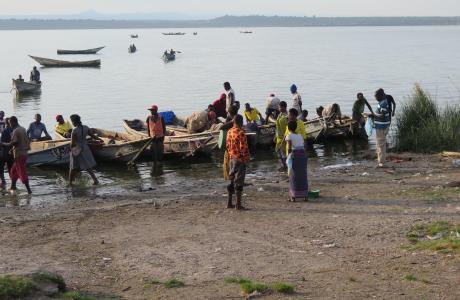Central African Savannas Prove Crucial Nature-Based Solution for Climate Change
A pioneering study in the Kongo Central province of the Democratic Republic of the Congo has underscored the critical role of Nature-based solutions in mitigating climate change and biodiversity loss. Scientists from the Royal Museum for Central Africa, Ghent University, and INERA (Institut National pour l’Études et la Recherche Agronomiques) have revealed the remarkable potential of fire exclusion in artificial ‘unstable’ mesic savannas as an effective strategy, published in Global Change Biology on 24 january 2024.

Key Findings:
- Carbon Stocks Recovery: After 17 years of fire exclusion, aboveground carbon recovery averaged around 11 Mg C per hectare, with an estimated potential full recovery after 115 years.
- Biodiversity: More than a third of the species richness of old growth forest was recovered after 17 years, with estimated potential full recovery after as little as 60 years. We observed a strong association between higher above ground carbon stocks and higher species richness. However, recovery of the original species composition of old growth forest, is predicted to take at least 120 years. This means that the number of tree species is increasing very fast, but it takes time before the targeted old-growth forest species take over.
- Global Impact: Extrapolating the findings, it is estimated that unstable savannas across DR Congo, Congo, and Angola could have a total carbon uptake potential of up to 12 Gt C by 2100.
Lead author Brice Yannick Djiofack emphasizes: “The relatively simple and cost-efficient measure of fire exclusion in artificial savannas is an effective nature-based solution to mitigate global change and fight biodiversity loss. It also offers a concrete opportunity to involve local communities and their traditional knowledge, while providing crucial scientific leverage for policymakers to boost forest restoration throughout the central African Congo Basin.”
Mr Djiofack continues “Successful forest restoration not only provides environmental benefits but also offers significant advantages to local communities, such as income generation through the sale of carbon credits, aiding community adaptation to climatic or environmental extremes, and supporting local development initiatives.”
Prof. Dr. Bhely Angoboy from INERA, highlights the need for a ‘bottom-up’ approach to identify suitable land for forest restoration initiatives. The study points out that an area of 120 Mha of unstable savannas is potentially suitable for large-scale forest restoration campaigns across Angola, Congo, and the DR Congo.
Senior author Prof. Dr. Wannes Hubau adds: “This research provides crucial insights for national and regional forest restoration initiatives and underscores the significance of ongoing monitoring and engagement with local communities in Nature-based solution initiatives. This is particularly significant in regions vulnerable to climate change impacts. Restoring carbon stocks and tree diversity not only mitigates global change but also enhances the resilience of local communities to the adverse effects of a changing climate.”
Prof. Hubau continues: “However, upscaling this management within the framework of global or regional initiatives (e.g. AFR100) is constrained due to uncertainties of the suitability of land and uncertainties on the long-term pathways of carbon and biodiversity recovery. Therefore, more ground-based in situ monitoring is needed to improve predictions of the benefits of large-scale Restoration initiatives and to quantify variation due to resource availability.”
This study, part of the PilotMAB project by the Service of Wood Biology of the Royal Museum for Central Africa (RMCA), was funded by the Belgian Directorate-General Development Cooperation and Humanitarian Aid (DGD).
Read the full article on https://onlinelibrary.wiley.com


